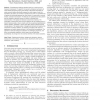Free Online Productivity Tools
i2Speak
i2Symbol
i2OCR
iTex2Img
iWeb2Print
iWeb2Shot
i2Type
iPdf2Split
iPdf2Merge
i2Bopomofo
i2Arabic
i2Style
i2Image
i2PDF
iLatex2Rtf
Sci2ools
109
click to vote
PAMI
2010
2010
Spatiotemporal Saliency in Dynamic Scenes
—A spatiotemporal saliency algorithm based on a center-surround framework is proposed. The algorithm is inspired by biological mechanisms of motion-based perceptual grouping and extends a discriminant formulation of center-surround saliency previously proposed for static imagery. Under this formulation, the saliency of a location is equated to the power of a predefined set of features to discriminate between the visual stimuli in a center and a surround window, centered at that location. The features are spatiotemporal video patches and are modeled as dynamic textures, to achieve a principled joint characterization of the spatial and temporal components of saliency. The combination of discriminant center-surround saliency with the modeling power of dynamic textures yields a robust, versatile, and fully unsupervised spatiotemporal saliency algorithm, applicable to scenes with highly dynamic backgrounds and moving cameras. The related problem of background subtraction is treated as the...
Related Content
| Added | 29 Jan 2011 |
| Updated | 29 Jan 2011 |
| Type | Journal |
| Year | 2010 |
| Where | PAMI |
| Authors | Vijay Mahadevan, Nuno Vasconcelos |
Comments (0)

